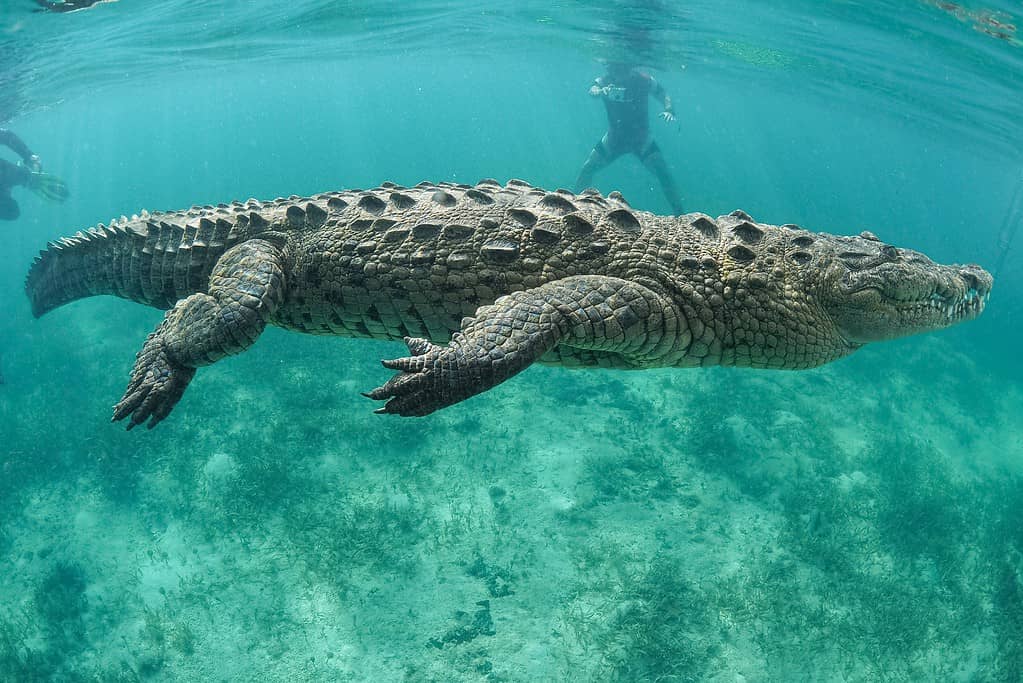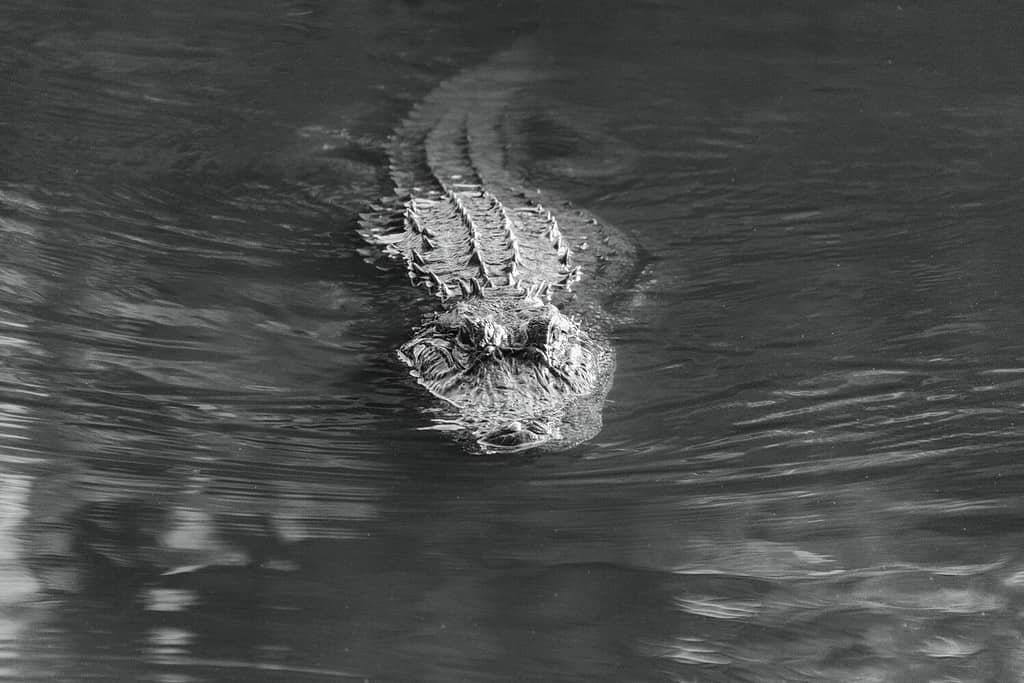We know that many animals are both predators and prey but to witness one going through both life experiences at the same time is quite something! This incredible footage was captured at Gatorland Wildlife Park in Orange County, Florida.
The park has more than 2,000 American alligators and crocodiles. At the start of the clip, a small alligator is stalking a white bird that looks like a stork.
Watch the Fascinating Footage Below
However, another larger reptile (a crocodile) approaches at speed and attacks the gator before it can launch an attack on the bird! The small gator puts up a brave fight but gets carried away into the pond. We don’t get to find out if it survives.
In a subsequent interview, the CEO of the park explained that this was not a predator-hunting prey. It was an irate mama crocodile defending her young!
American Crocodiles vs American Alligators

American crocodiles have a stronger bite force than alligators.
©Jesus Cobaleda/Shutterstock.com
We don’t know which species of crocodile is captured in this clip. However, we do know that the American crocodile (Crocodylus acutus) lives in Florida as well as Mexico, Peru, and Venezuela.
American alligators (Alligator mississippiensis) are also a native species of Florida. South Florida is the only place where these two species would exist together in the wild.
Both of these animals are members of the Crocodylidae family. It is not unusual for members of this family to hunt each other. It’s also true that crocodiles will eat other crocodiles.
Who Had the Advantage?

American alligators grow over 11 feet and can get up to 800 pounds.
©iStock.com/Bradley Proxmire
In this case, the croc was a lot larger than the gator and therefore had a clear advantage. This may be because the alligator was not fully grown but the croc was a mature female. American alligators grow to a maximum of just over 11 feet and can reach 800 pounds. American crocodiles, however, grow up to 20 feet long and can reach 2,000 pounds.
The crocodiles have a stronger bite force than the gator – 16,414 N compared to 13,172 N. Finally, crocs tend to be more territorial and are willing to attack with little provocation.
The moral of the story is – when you are stalking a bird, always check behind you!
How Large Can Crocodiles Get?

Male crocodiles are bigger than females.
©diegooscar01/Shutterstock.com
Male crocodiles are bigger than females and can grow up to around 20 feet long, although they usually don’t surpass 14 feet in the wild. Female crocodiles that are ready to breed are typically about 8 to 12 feet in length.
In fact, fossils show that the longest crocodile to exist was a Sarcosuchus imperator, measuring 40 feet in length and weighing 17,600 pounds.
The biggest crocodile in captivity right now is named “Cassius.” It lives in Marineland Crocodile Park, a zoo on Green Island, Queensland, Australia. Cassius is about 18 feet long and weighs around 2,900 pounds.
Is It Normal For an Alligator to Attack a Crocodile?

Alligators do not normally attack crocodiles. They most often eat fish and small amphibians.
©Mix Tape/Shutterstock.com
In the wild, it is not common for alligators to attack crocodiles. While both species are apex predators and may occasionally compete for resources in their shared habitats, direct confrontations resulting in attacks are relatively rare. Alligators typically exhibit a more docile temperament compared to their more aggressive counterparts, the crocodiles.
Alligators are opportunistic feeders and have a varied diet consisting of fish, amphibians, birds, small mammals, and reptiles. Their feeding preferences primarily depend on factors such as availability and abundance of prey within their environment. Younger alligators usually consume smaller prey items like insects or small fish until they grow larger and can tackle larger meals.
These aquatic creatures possess powerful jaws that exert tremendous bite force but lack the agility necessary to overpower adult crocodiles during encounters. Both species have evolved distinct adaptations enabling them to survive in different environments; alligators thrive predominantly in freshwater habitats, while crocodiles excel in brackish or saltwater environments.
How Can You Tell an Alligator and a Crocodile Apart?
If you were to encounter one of these reptilian monsters in the wild, how would you know if the creature is an alligator or a crocodile? In terms of physical characteristics, an alligator has a U-shaped snout, webbed feet, a wide upper jaw that hides the lower teeth and overlaps the lower jaw, and roughly 80 teeth. Its teeth measure from 1 inch for its smaller teeth to as much as 2 ½ inches for its largest. In color, alligators are dark gray or black with a cream underbelly.
Crocodiles, by comparison, have V-shaped snouts, feet that are not webbed but possess a jagged fringe, and upper and lower jaws that are roughly the same size, allowing the teeth to interdigitate. Crocodiles possess 60-70 teeth that are slightly curved and conical and protrude when their mouths are closed. Saltwater crocs have 66 teeth, some of which grow as long as 5 inches. Crocodiles’ teeth are not sharp, but are blunt, as they use them to hold prey tight rather than ripping them apart. Crocodiles are mostly olive green or light brown with a mottled pattern.
Alligators and crocodiles differ in size. While alligators weigh from 400 lbs to 800 lbs and range in length from 8.2 feet to 11.2 feet, crocodiles are larger animals, measuring 10 feet to 20 feet long and weighing 300 lbs to 2,000 lbs.
Alligators can be found in 2 locations–America (the American alligator) and China (the Chinese alligator). Crocodiles can be found in many more places worldwide: Egypt and 25 other countries in Africa (Nile crocodile), Asia, Oceania, South Florida, and South America (American crocodile). Regarding habitat, alligators prefer freshwater areas like swamps, rivers, lakes, ponds, and wetlands, while crocodiles are able to tolerate salt water, enabling them to inhabit lagoons and islands, as well as rivers, lakes, and mangrove swamps.
As far as prey goes, you’d likely observe either the alligator or crocodile eating the same animals: fish, birds, turtles, and various mammals. They are both apex predators that primarily consume other animals as their sole source of nutrition.
In conclusion, if you are observing one of these reptiles in the wild, you’ll need to take into account its unique characteristics, its size, and the area you are observing it in to determine whether it’s an alligator or a crocodile.
The photo featured at the top of this post is © RICIfoto/Shutterstock.com
Thank you for reading! Have some feedback for us? Contact the AZ Animals editorial team.







